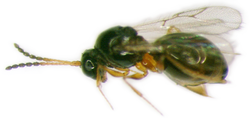| Leptopilina | |
|---|---|
 | |
| Leptopilina boulardii (Eucoilinae), a parasitoid of Drosophila | |
| Scientific classification | |
| Kingdom: | |
| Phylum: | |
| Class: | |
| Order: | |
| Family: | |
| Subfamily: | |
| Genus: | Leptopilina Förster, 1862 [1] |
Leptopilina is a genus of parasitoid wasp in the family Figitidae. The genus is best known for the three Drosophila parasitoids Leptopilina boulardi , Leptopilina heterotoma and Leptopilina clavipes, used to study host-parasite immune interactions. The venom released by L. heterotoma during oviposition contains virus-like particles that delay host larval development and suppress the host cellular immune response. [2] [3] There is no evidence that these virus-like particles are the products of viral DNA as described in other parasitoid taxa. [4]
L. japonica is a parasitoid of Drosophila suzukii which is an important pest in fruit production. [5] [6] It was first captured in November 2020 as bycatch from a Vespa mandarinia trap in Washington State [7] [8] [9] - the first find of this species in the United States. [7] [8] [9] This may help to control D. suzukii in North America. [7] [8] [9]